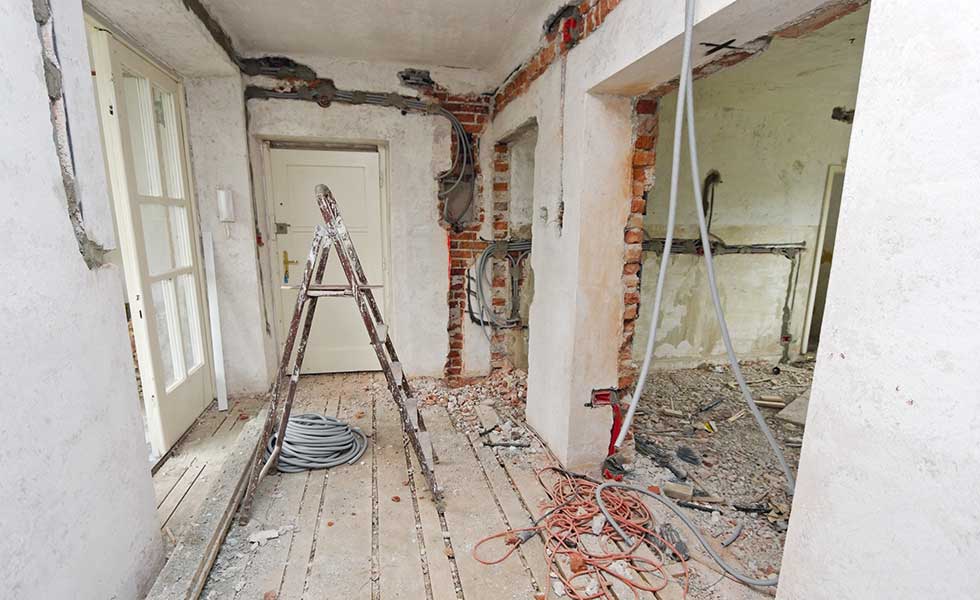Removing a load bearing wall: a beginner's guide
If you're considering removing a load bearing wall to open up a space, let experienced self-builder Michael Holmes help make your project a success

Renovating your home and considering removing a load bearing wall to create an open-plan space? Great idea... but it's not a task you should tackle without some research and, in some cases, expert advice from a structural engineer, too. Let experienced self-builder Michael Holmes help make your project a success: he looks at the practicalities of knocking through.
For more information on how to renovate a house, see our expert guide.
Are there any restrictions to removing a load bearing wall?
Almost any wall can be removed or altered, providing structural implications are taken into account. Removing internal partition walls does not require planning permission (unless the building is listed, in which case listed building consent is needed). All alterations must comply with the building regulations.
Leasehold property owners will need to get permission from the freeholder. Any work that involves alterations to a shared party wall or structure must comply with the Party Wall Act.
How do I know if a wall is load-bearing or not?
It will be obvious if a wall is load-bearing if it supports another wall in the storey above. If you’re unsure, a builder will usually be able to establish if it’s loadbearing or not by lifting the floor covering in the rooms above the wall. If the floor joists run parallel with the wall, it’s not load-bearing. If the floor joists sit on top of the internal wall and the floorboards run in the opposite direction, then it is a load-bearing wall.
A non load-bearing wall can be removed or opened up easily, with only cosmetic implications. However, make sure an electrician or plumber safely disconnects any services within, or on the wall, before demolition. If there is any doubt, consult a structural engineer (you can find one at istructe.org). If the wall is structural, they’ll be able to produce the calculations and drawings required.
How do I remove a load bearing wall?
Like you would a non-load bearing wall... but when a load-bearing wall is altered or removed, it will need to be replaced with a new load-bearing structure, typically rolled steel joists, supported on either steel posts or masonry columns with concrete pads cast into them.
Get small space home decor ideas, celeb inspiration, DIY tips and more, straight to your inbox!
There is usually a choice between forming a wide opening/archway, or removing the wall and concealing the steelwork within the ceiling void, and keeping supporting piers or columns to a minimum. If two or more intersecting load-bearing walls are removed, it is often necessary to leave a structural post or column in the room. Openings can be spanned by timber or reinforced concrete beams. Larger openings can be spanned by glulam beams (visit glulam.co.uk), made up from layers of laminated timber. They’re more eco-friendly than steel but tend to be much deeper, so they can’t be concealed.
In a traditional property, steel beams can be encased to look like timber beams. This is done by fixing a U-shaped resin mould around the beam (visit oakleaf.co.uk), or by wrapping it in a U-shaped envelope made from oak (oakmasters.co.uk).
How much does it cost to remove a load bearing wall?
This really depends on where you live, whether the job is part of a larger job or an individual piece of work (in which case expect it to cost more). As a ball park figure, expect to pay anywhere from £1,000 upwards.
More on renovating your home:
Michael is Director of Content & Product Development for Future Homes. Prior to this he was Editor in Chief of Real Homes magazine, Period Living and Homebuilding & Renovating and he also served as Editor of Homebuiling & Renovating for several years. As well as being an expert in renovation, having presented multiple property TV shows and authoring Renovating for Profit (Ebury, 2008), Michael has a personal and professional interest in self build and helps others achieve their dreams of building a unique home. He is also Deputy Chair of NaCSBA and has campaigned for the self-build sector for many years, regularly sitting with government parties to advise on the industry.